Quality of Life, Perceived Social Support, and Treatment Adherence Among Methadone Maintenance Program Users: An Observational Cross-Sectional Study
Abstract
1. Introduction
2. Materials and Methods
2.1. Design
2.2. Variables and Information Collection
2.3. Statistical Analysis
3. Results
4. Discussion
Strengths and Limitations of the Study
5. Conclusions
Author Contributions
Funding
Institutional Review Board Statement
Informed Consent Statement
Data Availability Statement
Acknowledgments
Conflicts of Interest
Abbreviations
| MMP | Methadone Maintenance Program |
| IQR | Interquartile range |
| CRL | Coefficient of linear regression |
| OR | Odds ratio |
| 95% CI | 95% confidence interval |
| HIV | Human immunodeficiency virus |
Appendix A
STROBE Checklist
| Item | Recommendation | Page | |
| Title and abstract | 1 | (a) Indicate the study’s design with a commonly used term in the title or the abstract | 1 |
| (b) Provide in the abstract an informative and balanced summary of what was done and what was found | 1 | ||
| Introduction | |||
| Background/rationale | 2 | Explain the scientific background and rationale for the investigation being reported | 2 |
| Objectives | 3 | State specific objectives, including any prespecified hypotheses | 2–3 |
| Methods | |||
| Study design | 4 | Present key elements of study design early in the paper | 3 |
| Setting | 5 | Describe the setting, locations, and relevant dates, including periods of recruitment, exposure, follow-up, and data collection | 3 |
| Participants | 6 | (a) Give the eligibility criteria, and the sources and methods of selection of participants | 3 |
| Variables | 7 | Clearly define all outcomes, exposures, predictors, potential confounders, and effect modifiers. Give diagnostic criteria, if applicable | 3 |
| Data sources/measurement | 8 * | For each variable of interest, give sources of data and details of methods of assessment (measurement). Describe comparability of assessment methods if there is more than one group | 3 |
| Bias | 9 | Describe any efforts to address potential sources of bias | 13 |
| Study size | 10 | Explain how the study size was arrived at | 3 |
| Quantitative variables | 11 | Explain how quantitative variables were handled in the analyses. If applicable, describe which groupings were chosen and why | 3–4 |
| Statistical methods | 12 | (a) Describe all statistical methods, including those used to control for confounding | 3–4 |
| (b) Describe any methods used to examine subgroups and interactions | 4 | ||
| (c) Explain how missing data were addressed | N/A * | ||
| (d) If applicable, describe analytical methods taking account of sampling strategy | N/A * | ||
| (e) Describe any sensitivity analyses | N/A * | ||
| Results | |||
| Participants | 13 * | (a) Report numbers of individuals at each stage of study—e.g., numbers potentially eligible, examined for eligibility, confirmed eligible, included in the study, completing follow-up, and analysed | 3 |
| (b) Give reasons for non-participation at each stage | 3 | ||
| (c) Consider use of a flow diagram | 3 | ||
| Descriptive data | 14 * | (a) Give characteristics of study participants (e.g., demographic, clinical, social) and information on exposures and potential confounders | 4–7 |
| (b) Indicate number of participants with missing data for each variable of interest | 7 | ||
| Outcome data | 15 * | Report numbers of outcome events or summary measures | 7–11 |
| Main results | 16 | (a) Give unadjusted estimates and, if applicable, confounder-adjusted estimates and their precision (e.g., 95% confidence interval). Make clear which confounders were adjusted for and why they were included | 4 |
| (b) Report category boundaries when continuous variables were categorized | 4 | ||
| (c) If relevant, consider translating estimates of relative risk into absolute risk for a meaningful time period | N/A * | ||
| Other analyses | 17 | Report other analyses done—e.g., analyses of subgroups and interactions, and sensitivity analyses | N/A * |
| Discussion | |||
| Key results | 18 | Summarise key results with reference to study objectives | 11 |
| Limitations | 19 | Discuss limitations of the study, taking into account sources of potential bias or imprecision. Discuss both direction and magnitude of any potential bias | 13 |
| Interpretation | 20 | Give a cautious overall interpretation of results considering objectives, limitations, multiplicity of analyses, results from similar studies, and other relevant evidence | 11–13 |
| Generalisability | 21 | Discuss the generalisability (external validity) of the study results | 11–13 |
| Other information | |||
| Funding | 22 | Give the source of funding and the role of the funders for the present study and, if applicable, for the original study on which the present article is based | 13 |
| * N/A: Not applicable. | |||
Appendix B
Ad Hoc Questionnaire
- 1.
- What studies have you done?
- I did not finish school.
- I only went to school.
- I only completed secondary education.
- I only completed high school.
- I went to college or higher.
- 2.
- What is your current marital status?
- Single
- Married
- Divorced/Separated
- Widowed
- With a partner
- 3.
- Are you currently working?
- Yes
- No
- 4.
- How many children do you have?
- 0
- 1
- 2
- 3
- 4
- 5 or more
- 5.
- Have you been in jail?
- Yes
- No
- 6.
- Where are you from?
- Spain
- Other (Indicate where on the dotted line) …………………………………………….
- 7.
- Do you currently live with someone?
- I live alone.
- I live with my partner.
- I live with my partner and my children.
- I live with my children.
- I share a house.
- I am currently living on the street.
- 8.
- How long have you been enrolled in the methadone program? Approximately
- Less than 1 year
- Between 1 year and 5 years
- Between 5 years and 10 years
- Between 10 years and 20 years
- Between 20 years and 30 years
- More than 30 years
References
- Agency EUD. Heroin and Other Opioids-the Current Situation in Europe (European Drug Report 2025). 2025. Available online: https://www.euda.europa.eu/publications/european-drug-report/2025/heroin-and-other-opioids_en#edr25-section-heroin-market (accessed on 4 June 2025).
- United Nations. World Drug Report 2024. 2024. Available online: https://www.unodc.org/documents/data-and-analysis/WDR_2024/2410189S.pdf (accessed on 4 June 2025).
- Delargy, I.; Crowley, D.; Van Hout, M.C. Twenty years of the methadone treatment protocol in Ireland: Reflections on the role of general practice. Harm Reduct. J. 2019, 16, 5. [Google Scholar] [CrossRef] [PubMed]
- OMS. International Statistical Classification of Diseases and Related Health Problems—11th Version. 2019. Available online: https://www.who.int/standards/classifications/classification-of-diseases (accessed on 4 June 2025).
- Ministerio de Sanidad, Delegación del Gobierno para el Plan Nacional Sobre Drogas. Observatorio Español de las Drogas y las Adicciones. Estadísticas 2023. Alcohol, Tabaco y Drogas Ilegales en España. Madrid; 2023. Available online: https://pnsd.sanidad.gob.es/ (accessed on 4 June 2025).
- Fredericksen, R.J.; Baker, R.; Sibley, A.; Estadt, A.T.; Colston, D.; Mixson, L.S.; Walters, S.; Bresett, J.; Levander, X.A.; Leichtling, G.; et al. Motivation and context of concurrent stimulant and opioid use among persons who use drugs in the rural United States: A multi-site qualitative inquiry. Harm Reduct. J. 2024, 21, 74. [Google Scholar] [CrossRef]
- Ovservatorio Español de las Drogas las Adicciones. Informe 2024. Alcohol, Tabaco y Drogas Ilegales en España. 2024. Available online: https://pnsd.sanidad.gob.es/ (accessed on 7 June 2025).
- Family, H.E.; Vojt, G.; Poulter, H.; Bailey, C.P.; Abdala Sheikh, A.P.; Cavallo, D.; Karimi, S.; Booth, N.; Da Silva, P.; Aitken, L.; et al. A qualitative study of benzodiazepine/z-drug and opioid co-use patterns and overdose risk. Harm Reduct. J. 2025, 22, 24. [Google Scholar] [CrossRef]
- Rivera, B.; Casal, B.; Currais, L. The social cost of illicit drugs use in Spain. Int. J. Drug Policy 2017, 44, 92–104. [Google Scholar] [CrossRef] [PubMed]
- Roncero, C.; Barral, C.; Rodríguez-Cintas, L.; Pérez-Pazos, J.; Martinez-Luna, N.; Casas, M.; Torrens, M.; Grau-López, L. Psychiatric comorbidities in opioid-dependent patients undergoing a replacement therapy programme in Spain: The PROTEUS study. Psychiatry Res. 2016, 243, 174–181. [Google Scholar] [CrossRef]
- Dematteis, M.; Auriacombe, M.; D’Agnone, O.; Somaini, L.; Szerman, N.; Littlewood, R.; Alam, F.; Alho, H.; Benyamina, A.; Bobes, J.; et al. Recommendations for buprenorphine and methadone therapy in opioid use disorder: A European consensus. Expert Opin. Pharmacother. 2017, 18, 1987–1999. [Google Scholar] [CrossRef] [PubMed]
- Pérez, E.; Ruiz, S.; Pérez, E.; Ruiz, S. El consumo de sustancias como factor de riesgo para la conducta delictiva: Una revisión sistemática. Acción Psicológica. Accion Psicol. 2017, 14, 33–50. Available online: https://scielo.isciii.es/scielo.php?script=sci_arttext&pid=S1578-908X2017000200003&lng=es&nrm=iso&tlng=es (accessed on 10 June 2025). [CrossRef]
- Carr, M.M.; Mannes, Z.L.; Oberleitner, L.M.S.; Oberleitner, D.E.; Beitel, M.; Gazzola, M.G.; Madden, L.M.; Zheng, X.; Barry, D.T. The impact of body image dissatisfaction on psychological distress and health-related quality of life among patients in methadone treatment. Am. J. Addict. 2023, 32, 460–468. [Google Scholar] [CrossRef]
- SAMHSA. Treatment Improvement Protocol: Medications for Opioid Use Disorder. 2021. Available online: https://library.samhsa.gov/sites/default/files/pep21-02-01-002.pdf (accessed on 7 June 2025).
- Hosseini, S.H.; Fendereski, F.; Yazdani, F.; Hamzehgardeshi, Z. Exploring perceived quality of life in long-term methadone-dependent patients: A qualitative study. Harm Reduct. J. 2024, 21, 225. [Google Scholar] [CrossRef]
- Pascual-Pastor, F.; Muñoz, Á.; Oraa, R.; Flórez, G.; Notario, P.; Seijo, P.; Gonzalvo, B.; Assaf, C.; Gómez, M.; Casado, M.Á. Satisfacción y experiencia de pacientes en tratamiento con sustitutivos opiodes en España. Estudio PREDEPO. Adicciones 2023, 35, 433–444. Available online: http://www.adicciones.es (accessed on 13 June 2025). [CrossRef]
- Cao, P.; Zhang, Z.; Zhong, J.; Xu, S.; Huang, Q.; Fan, N. Effects of treatment status and life quality on anxiety in MMT patients. Subst Abus. Treat. Prev. Policy 2021, 16, 9. [Google Scholar] [CrossRef] [PubMed]
- Xu, Y.M.; Zhong, B.L.; Chen, W.C.; Zhu, J.H.; Lu, J. Suicidal ideation among Chinese methadone-maintained patients: Prevalence and correlates. Oncotarget 2017, 8, 86181–86187. [Google Scholar] [CrossRef] [PubMed]
- Aghayan, S.; Amiri, M.; Chaman, R.; Khosravi, A. Quality of life in methadone maintenance treated patients in Iran. Int. J. High Risk Behav. Addict. 2015, 4, e22275. [Google Scholar] [CrossRef] [PubMed]
- Diaz-Negrete, D.B.; Velázquez-Altamirano, M.; Benítez-Villa, J.L.; Fernández-Cáceres, C. Psychosocial reintegration process in patients who receive maintenance treatment with methadone: A qualitative analysis. Salud Ment. 2019, 42, 173–184. [Google Scholar] [CrossRef]
- Zhou, K.; Li, H.; Wei, X.; Li, X.; Zhuang, G. Relationships between perceived social support and retention among patients in methadone maintenance treatment in mainland China. Psychol. Health Med. 2016, 22, 493–500. [Google Scholar] [CrossRef]
- Tun, S.; Balasingam, V.; Singh, D. Factors associated with quality of life (QOL) scores among methadone patients in Myanmar. PLoS Glob. Public Health 2022, 2, e0000469. [Google Scholar] [CrossRef]
- Kollerits, E.; Zsila, Á.; Matuszka, B. Quality of life, social support, and adherence in female patients with thyroid disorders. BMC Women’s Health 2023, 23, 567. Available online: https://pubmed.ncbi.nlm.nih.gov/37919706/ (accessed on 16 July 2025). [CrossRef]
- Ivarsson, B.; Hesselstrand, R.; Rådegran, G.; Kjellström, B. Health-related quality of life, treatment adherence and psychosocial support in patients with pulmonary arterial hypertension or chronic thromboembolic pulmonary hypertension. Chronic Respir. Dis. 2018, 16, 1479972318787906. [Google Scholar] [CrossRef]
- Sun, H.; Francis, H.M.; Polo, J.; Esposito, C.; Papia, K.; Yeley, J.; Brant, M.; Huenger, A.; Wang, J.; Brown, C.; et al. The Impact of Personal-Level Social Networks on Treatment Adherence, Depression, Anxiety, and Perceived Stigma Among Adults with Cystic Fibrosis: An Egocentric Network Analysis. Int. J. Behav. Med. 2025. online ahead of print. [Google Scholar] [CrossRef]
- Merchant, T.; DiTosto, J.D.; Gomez-Roas, M.; Williams, B.R.; Niznik, C.M.; Feinglass, J.; Grobman, W.A.; Yee, L.M. The Role of Social Support on Self-Management of Gestational Diabetes Mellitus: A Qualitative Analysis. J. Midwifery Women’s Health 2025. online ahead of print. [Google Scholar] [CrossRef]
- Hoang, V.L.; Green, T.; Bonner, A. Examining social support, psychological status and health-related quality of life in people receiving haemodialysis. J. Ren. Care 2022, 48, 102–111. Available online: https://pubmed.ncbi.nlm.nih.gov/34041850/ (accessed on 16 July 2025). [CrossRef] [PubMed]
- Szymczak, H.; Brandstetter, S.; Blecha, S.; Dodoo-Schittko, F.; Rohr, M.; Bein, T.; Apfelbacher, C. Social support and recovery in acute respiratory distress syndrome survivors: A prospective cohort study. ERJ Open Res. 2025, 11, 01113-2024. Available online: https://pubmed.ncbi.nlm.nih.gov/40661929/ (accessed on 16 July 2025). [CrossRef] [PubMed]
- Ministerio de Sanidad, Delegación del Gobierno para el Plan Nacional Sobre Drogas. Observatorio Español de las Drogas y las Adicciones. Informe 2022 Alcohol, Tabaco y Drogas Ilegales en España. Madrid; 2022. Available online: https://pnsd.sanidad.gob.es/ (accessed on 12 July 2025).
- INE. Población de Cádiz. 2025. Available online: https://www.ine.es/jaxi/Tabla.htm?path=/t20/e242/p03/a2001/l0/&file=mun11.px&L=0 (accessed on 11 July 2025).
- Servicio Provincial de Drogodependencia de Cádiz. Informe de Memoria 2020. Available online: https://www.dipucadiz.es/export/sites/default/drogodependencias/.galeria_ficheros/documentos/Memoria-completa-SPD-Cadiz-2020.pdf (accessed on 10 July 2025).
- Servicio de Drogodependencias de la Diputación de Cádiz Informe sobre el Indicador Admisiones a Tratamiento a Sustancias o por Comporta Mentales en Cádiz 2020. 2021. Available online: https://www.dipucadiz.es/export/sites/default/drogodependencias/.galeria_ficheros/documentos/Informe-sobre-el-Indicador-de-Admisiones-a-Tratamiento-2020.pdf (accessed on 15 July 2025).
- Badia, X.; Salamero, M.; Alonso, J. La Medida de la Salud: Guía de Escalas de Medición en Español; Tecnología y Ediciones del Conocimiento: Barcelona, Spain, 2007. [Google Scholar]
- De las Cuevas, C.; Peñate, W. Psychometric properties of the eight-item Morisky Medication Adherence Scale (MMAS-8) in a psychiatric outpatient setting. Int. J. Clin. Health Psychol. 2015, 15, 121–129. [Google Scholar] [CrossRef] [PubMed]
- Lozano-Hernández, C.M.; Cladellas, Y.P.; Gil Conesa, M.; Garin, O.; Forés, M.F.; del Cura-González, I. Functional social support: A systematic review and standardized comparison of different versions of the DUFSS questionnaire using the EMPRO tool. PLoS ONE 2023, 18, e0291635. [Google Scholar] [CrossRef]
- WHO. WHOQOL-BREF: Introduction, Administration, Scoring and Generic Version of the Assessment: Field Trial Version. 1996. Available online: https://www.who.int/publications/i/item/WHOQOL-BREF (accessed on 15 July 2025).
- Chaves Torres, N.M.; Echeverri Sarmiento, J.E.; Ballesteros, D.A.; Quijano Rodriguez, J.; Camacho, D. Validación de la escala de Morisky de 8 ítems en pacientes con enfermedad renal crónica. Revista Med. 2016, 24, 23–32. [Google Scholar] [CrossRef]
- Bellón-Saameño, J.A.; Delgado-Sánchez, A.; de Dios Luna del Castillo, J.; Claret, P.L. Validez y fiabilidad del cuestionario de apoyo social funcional Duke-UNC-11. Aten Primaria 1996, 18, 153–163. [Google Scholar]
- Lucas-Carrasco, R. The WHO quality of life (WHOQOL) questionnaire: Spanish development and validation studies. Qual. Life Res. 2012, 21, 161–165. [Google Scholar] [CrossRef]
- Zhou, K.; Wang, D.; Li, H.; Wei, X.; Yin, J.; Liang, P.; Kou, L.; Hao, M.; You, L.; Li, X.; et al. Bidirectional relationships between retention and health-related quality of life in Chinese mainland patients receiving methadone maintenance treatment. PLoS ONE 2017, 12, e0179009. [Google Scholar] [CrossRef]
- Aas, C.F.; Vold, J.H.; Skurtveit, S.; Lim, A.G.; Ruths, S.; Islam, K.; Askildsen, J.E.; Løberg, E.-M.; Fadnes, L.T.; Johansson, K.A. Health-related quality of life of long-term patients receiving opioid agonist therapy: A nested prospective cohort study in Norway. Treat. Prev. Policy 2020, 15, 68. [Google Scholar] [CrossRef]
- Chang, H.M.; Huang, M.C.; Fang, S.C.; Lin, S.K. Quality of life and associated factors of heroin-dependent patients receiving methadone and buprenorphine maintenance treatment. Neuropsychopharmacol. Rep. 2023, 43, 607–615. [Google Scholar] [CrossRef]
- Ministerio de Sanidad Consumo y Bienestar Social. Encuesta Nacional de Salud—España 2017 (ENSE 2017); 2018. Available online: https://www.sanidad.gob.es/estadEstudios/estadisticas/encuestaNacional/encuesta2017.htm (accessed on 12 July 2025).
- Nguyen, H.T.T.; Tran, D.Q.; Dinh, D.X. Social support status and associated factors among methadone maintenance patients: A multicentre, cross-sectional study in Vietnam during the COVID-19 pandemic. BMJ Open 2024, 14, e081519. [Google Scholar] [CrossRef] [PubMed]
- Farmaindustria, F. Encuesta Sobre Adherencia Terapéutica en España. 2015. Available online: https://www.farmaindustria.es/web/wp-content/uploads/sites/2/2016/12/Informe-Estudio-de-adherencia-anx.pdf (accessed on 28 July 2025).
- Nguyen, L.H.; Nguyen, H.T.T.; Nguyen, H.L.T.; Tran, B.X.; Latkin, C.A. Adherence to methadone maintenance treatment and associated factors among patients in Vietnamese mountainside areas. Subst. Abus. Treat. Prev. Policy 2017, 12, 31. [Google Scholar] [CrossRef] [PubMed]
- Ballesta-Gómez, R.; Millán-Jimenez, A.; Tena-Aguilar, M.; Ruiz-Benítez, B.; Alaminos-Romeo, F.J.; Montero-López, O. La Población Andaluza Ante las Drogas XV; Cáritas Española: Madrid, Spain, 2022. [Google Scholar]
- INE. Datos Estadísticos de paro Registrado y Contratos por Municipios y Actividad Económica (más de 45.000 Habitantes y Capitales) | Servicio Público de Empleo Estatal. 2025. Available online: https://www.sepe.es/HomeSepe/que-es-el-sepe/estadisticas/datos-estadisticos/municipios-capitales/2025/febrero.html (accessed on 29 June 2025).
- INE. Encuesta de Población Activa (EPA). Cuarto Trimestre 2024. 2024. Available online: https://www.ine.es/dyngs/Prensa/EPA4T24.htm (accessed on 4 July 2025).
- Tran, B.X.; Nguyen, L.H.; Nong, V.M.; Nguyen, C.T.; Phan, H.T.T.; Latkin, C.A. Behavioral and quality-of-life outcomes in different service models for methadone maintenance treatment in Vietnam. Harm Reduct. J. 2016, 13, 4. [Google Scholar] [CrossRef] [PubMed]
- Van Nguyen, H.; Nguyen, H.L.T.; Mai, H.T.; Le, H.Q.; Tran, B.X.; Hoang, C.D.; Le, H.T.; Nguyen, C.T.; Tran, T.D.; Latkin, C.A.; et al. Stigmatization among methadone maintenance treatment patients in mountainous areas in northern Vietnam. Harm Reduct. J. 2017, 14, 1. [Google Scholar] [CrossRef]
- INE. Penas de Prisión Según Duración de la pena, sexo, edad y Nacionalidad. 2025. Available online: https://www.ine.es/jaxiT3/Datos.htm?t=25715#_tabs-tabla%20/ (accessed on 12 July 2025).
- Ministerio del Interior. Estudio de Reincidencia Penitenciaria 2009–2019. 2022. Available online: https://www.interior.gob.es/opencms/pdf/archivos-y-documentacion/documentacion-y-publicaciones/publicaciones-descargables/instituciones-penitenciarias/Estudio_de_reincidencia_penitenciaria_2009-2019_DP-30_126220415.pdf (accessed on 28 June 2025).
- Ministerio de Sanidad Servicios Sociales e Igualdad. Plan Estratégico para el Abordaje de la Hepatitis C en el Sistema Nacional de Salud. 2015 June. Available online: https://www.sanidad.gob.es/ciudadanos/enfLesiones/enfTransmisibles/hepatitisC/PlanEstrategicoHEPATITISC/docs/plan_estrategico_hepatitis_C.pdf (accessed on 12 July 2025).
- Ministerio de Sanidad. Plan Estratégico para la Prevención y Control de la Infección por el VIH y las ITS en España. 2021–2030. 2023. Available online: https://cpage.mpr.gob.es (accessed on 30 March 2025).
- Muller, A.E. A Systematic Review of Quality of Life Assessments of Offenders. Int. J. Offender Ther. Comp. Criminol. 2020, 64, 1364–1397. [Google Scholar] [CrossRef]
- OECD. Education at a Glance 2024: OECD Indicators. 2024. Available online: https://doi.org/10.1787/c00cad36-en (accessed on 11 July 2025).
- Velaithan, V.; Tan, M.M.; Yu, T.F.; Liem, A.; Teh, P.L.; Su, T.T. The Association of Self-Perception of Aging and Quality of Life in Older Adults: A Systematic Review. Gerontol. 2024, 64, gnad041. [Google Scholar] [CrossRef]
- Pedrero-Pérez, E.J.; Barreda-Marina, M.A.; Bartolomé-Gil, C.; Bosque-Coro, S.; Callejo-Escobar, J.; Ema-López, I.; Dominguez-Aranda, M.A.; Ferrero-Herreros, Y.E.; Galera-García, Ó.; Garrido-Ureña, B.; et al. Calidad de vida en pacientes tratados con metadona: El WHOQOL-BREF, estudio psicométrico y resultados de aplicación. An. Psicol. 2018, 34, 251–257. [Google Scholar] [CrossRef]
- INE. Renta por Persona y Unidad Consumo por Comunidades Autónomas. 2025. Available online: https://www.ine.es/jaxiT3/Datos.htm?t=9947#_tabs-tabla (accessed on 6 July 2025).
- Ali, N.; Aziz, S.A.; Nordin, S.; Mi, N.C.; Abdullah, N.; Paranthaman, V.; Mahmud, M.; Yee, A.; Danaee, M. Evaluation of Methadone Treatment in Malaysia: Findings from the Malaysian Methadone Treatment Outcome Study (MyTOS). Subst. Use Misuse 2018, 53, 239–248. [Google Scholar] [CrossRef]
- Pedrero-Pérez, E.J.; MethaQoL, G. Dosis de metadona y su relación con calidad de vida, satisfacción, psicopatología, rendimiento cognitivo y consumo adicional de sustancias no prescritas. Adicciones 2016, 29, 37–54. [Google Scholar] [CrossRef]
- Fei, J.T.B.; Yee, A.; Habil, M.H.B.; Danaee, M. Effectiveness of Methadone Maintenance Therapy and Improvement in Quality of Life Following a Decade of Implementation. J. Subst. Abus. Treat. 2016, 69, 50–56. [Google Scholar] [CrossRef]
- Hurst, J.R.; Skolnik, N.; Hansen, G.J.; Anzueto, A.; Donaldson, G.C.; Dransfield, M.T.; Varghese, P. Understanding the impact of chronic obstructive pulmonary disease exacerbations on patient health and quality of life. Eur. J. Intern. Med. 2020, 73, 1–6. [Google Scholar] [CrossRef] [PubMed]
- Saqlain, M.; Riaz, A.; Ahmed, A.; Kamran, S.; Bilal, A.; Ali, H. Predictors of Health-Related Quality of Life Status Among Elderly Patients with Cardiovascular Diseases. Value Health Reg. Issues 2021, 24, 130–140. [Google Scholar] [CrossRef]
- Chuang, S.; Wu, J.; Wang, C. Resilience and Quality of Life in People with Mental Illness: A Systematic Review and Meta-Analysis. Neuropsychiatr. Dis. Treat. 2023, 19, 507–514. [Google Scholar] [CrossRef]
- Brennan-Ing, M. Diversity, stigma, and social integration among older adults with HIV. Eur. Geriatr. Med. 2018, 10, 239–246. [Google Scholar] [CrossRef]
- Romero-Serrano, R.; Casado Mejía, R.; Rebollo Catalán, M.A.; García-Iglesias, J.J.; Gómez-Salgado, J.; Lancharro Tavero, I. Influencia de las redes de apoyo sociofamiliares en el cuidado de las personas mayores dependientes: Un estudio cualitativo. Rev. Española Salud Pública 2023, 97, e202311095. [Google Scholar]
- Perez Torres, V. Percepción de Apoyo Social Dentro y Fuera del Entorno Laboral y su Relación con las Actitudes Hacia el Trabajo y los Riesgos Psicosociales en Trabajadores con Discapacidad. Ph.D. Thesis, Universidad Rey Juan Carlos, Madrid, Spain, 2011. [Google Scholar]
- Lakey, B.; Orehek, E. Relational regulation theory: A new approach to explain the link between perceived social support and mental health. Psychol. Rev. 2011, 118, 482–495. [Google Scholar] [CrossRef]
- Division of Mental Health and Prevention of Substance, World Health Organization. Programme on Mental Health. WHOQOL User Manual; WHO: Geneva, Switzerland, 2012. [Google Scholar]
- Ministerio de Sanidad, Delegación del Gobierno para el Plan Nacional sobre Drogas. Observatorio Español de las Drogas y las Adicciones. Informe 2021. Alcohol, Tabaco y Drogas Ilegales en España. Madrid. 2021. Available online: https://pnsd.sanidad.gob.es/ (accessed on 10 July 2025).
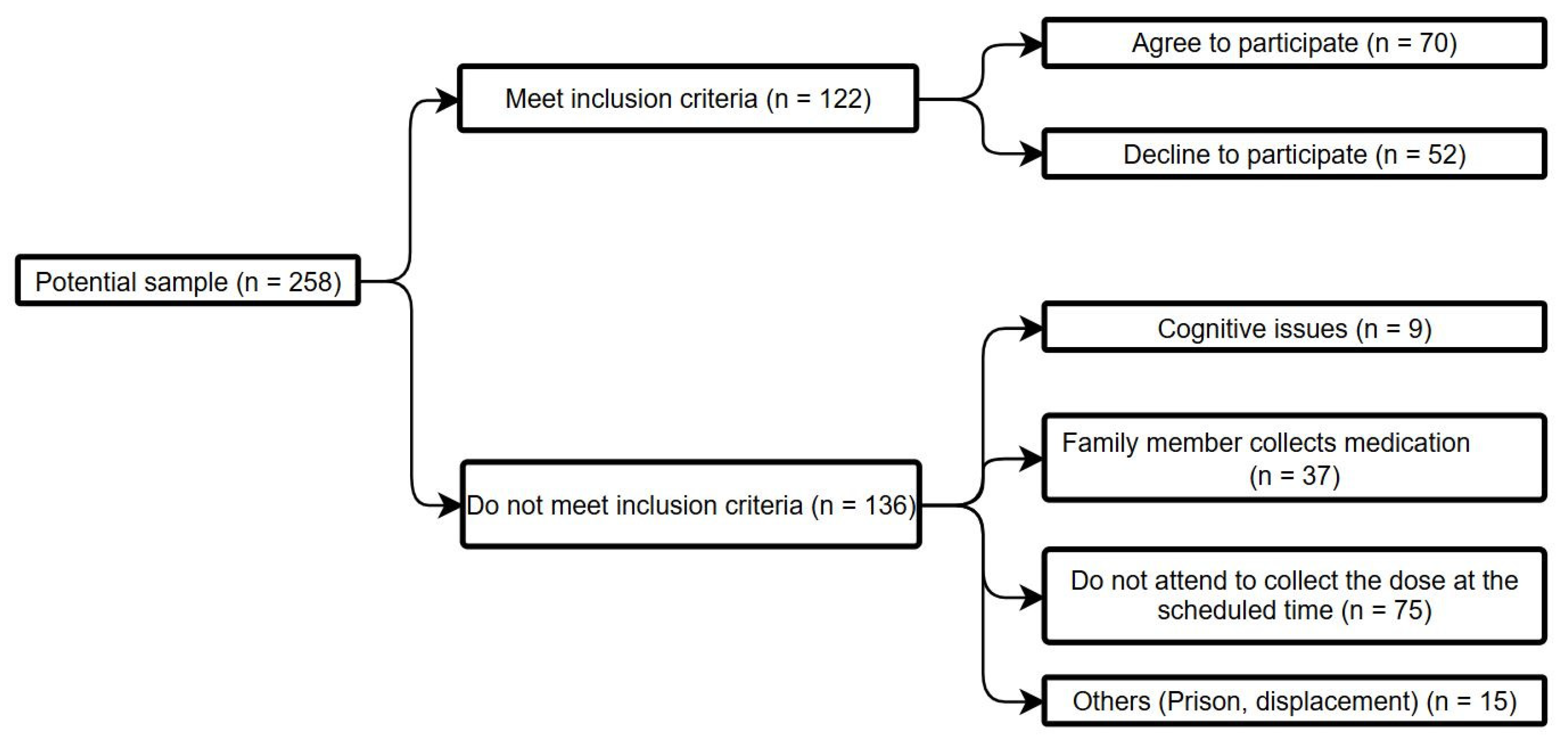
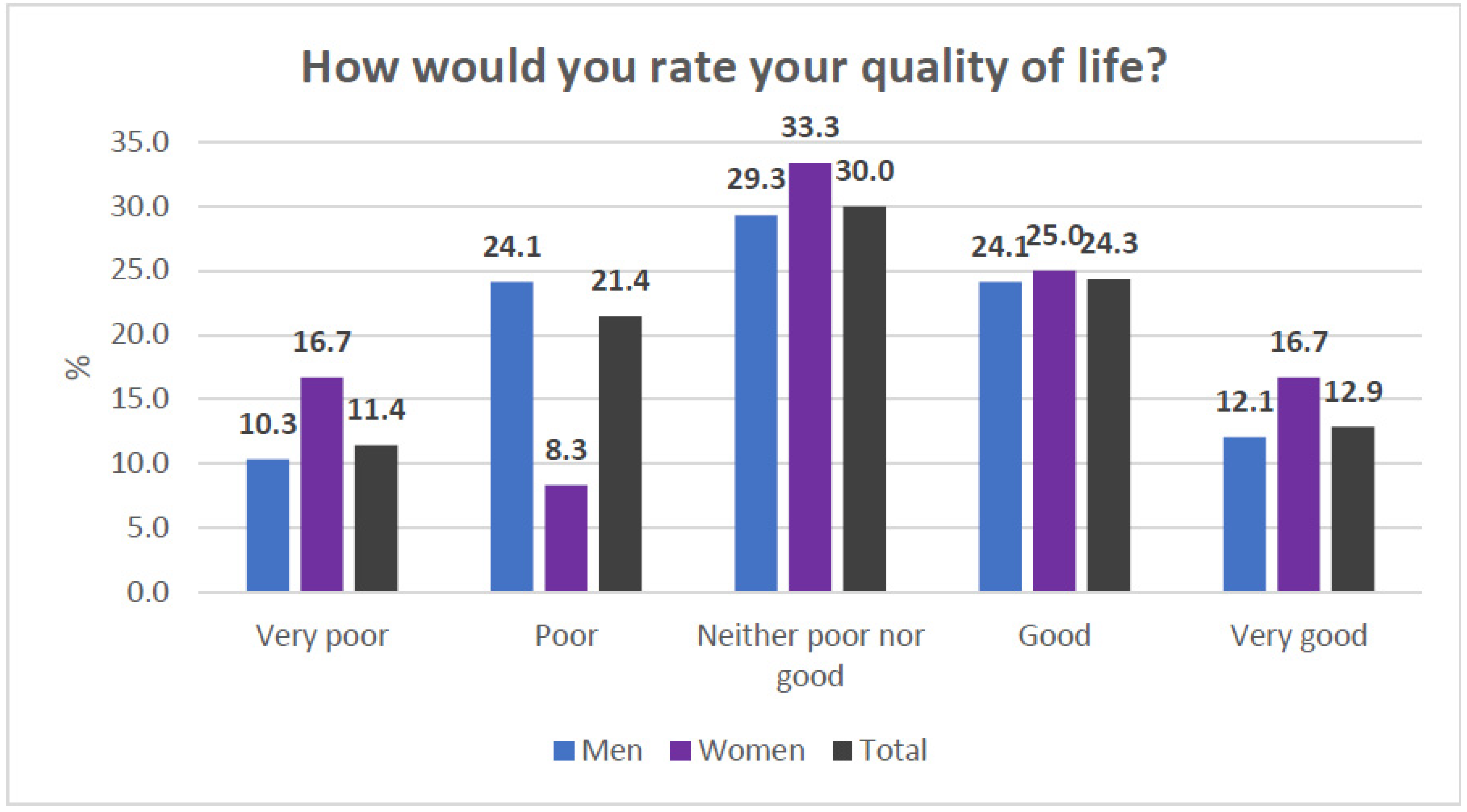
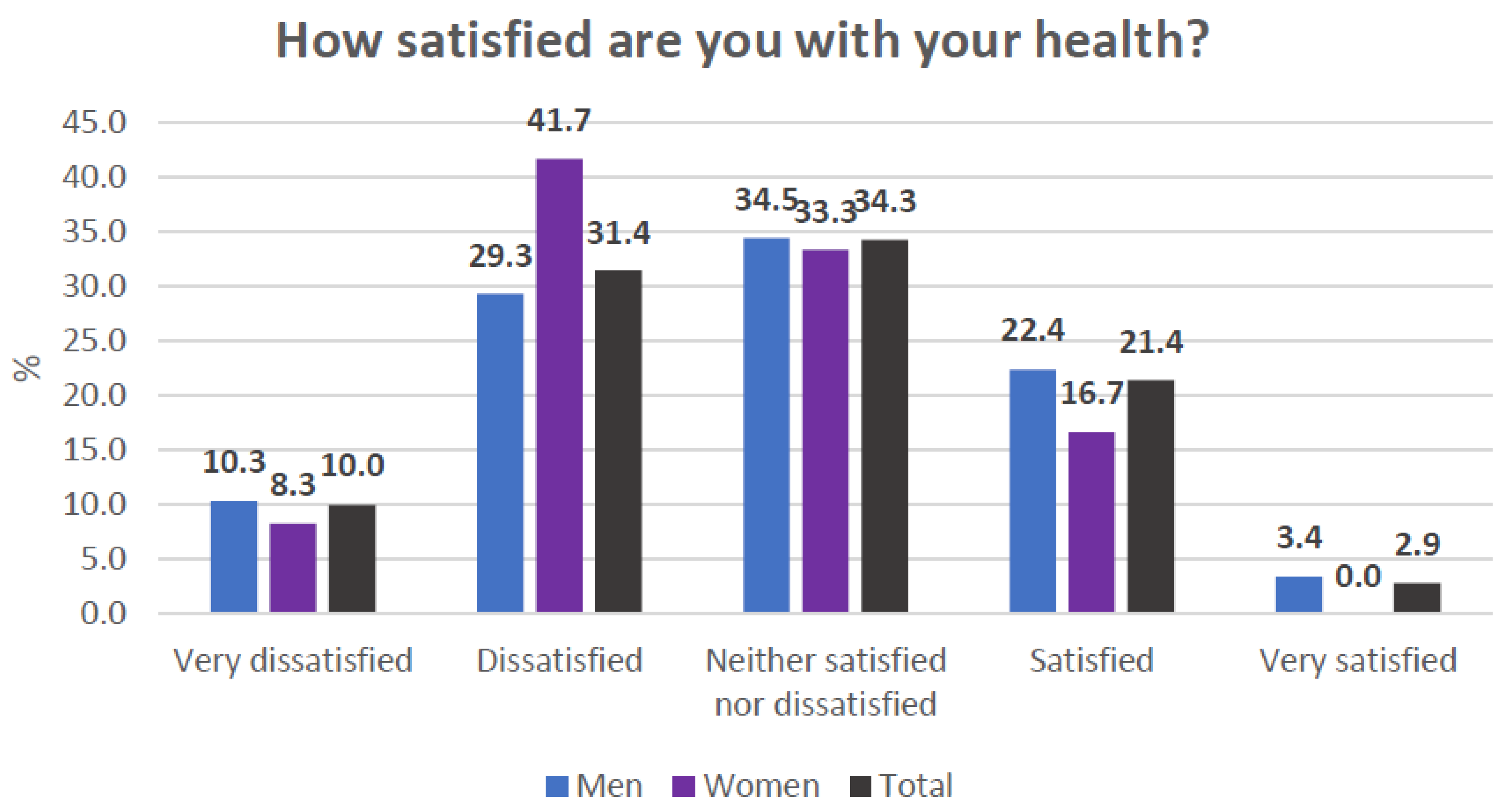
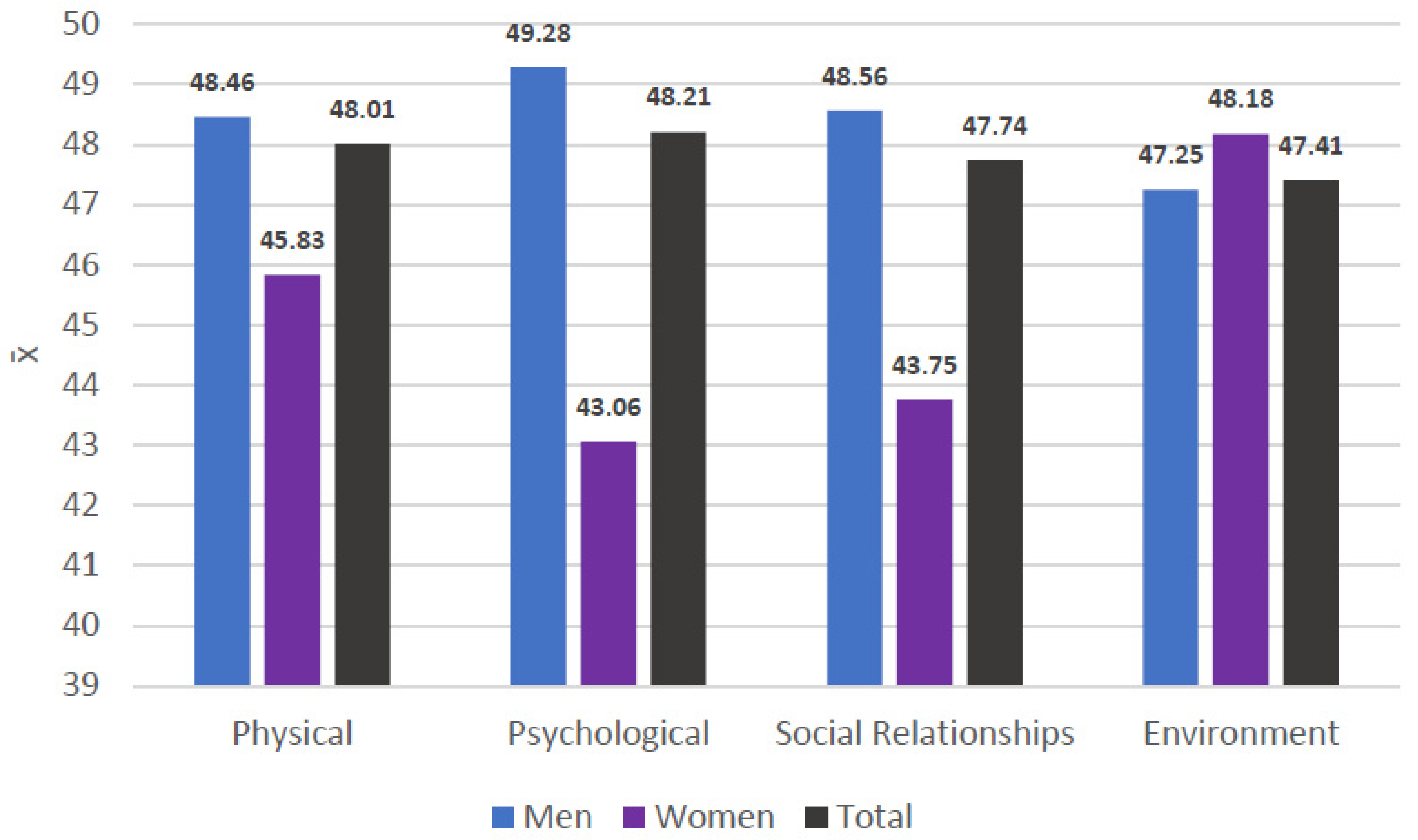
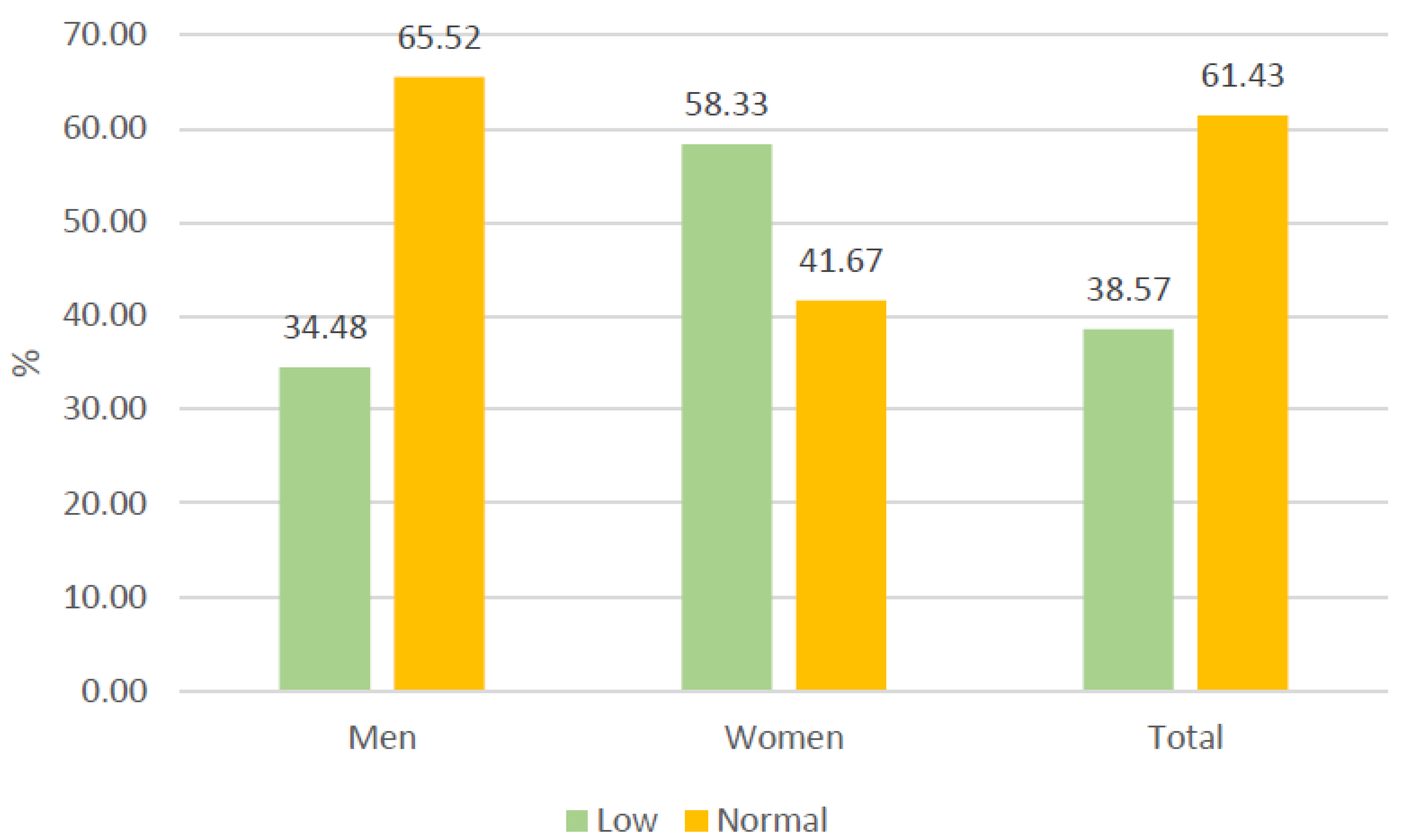
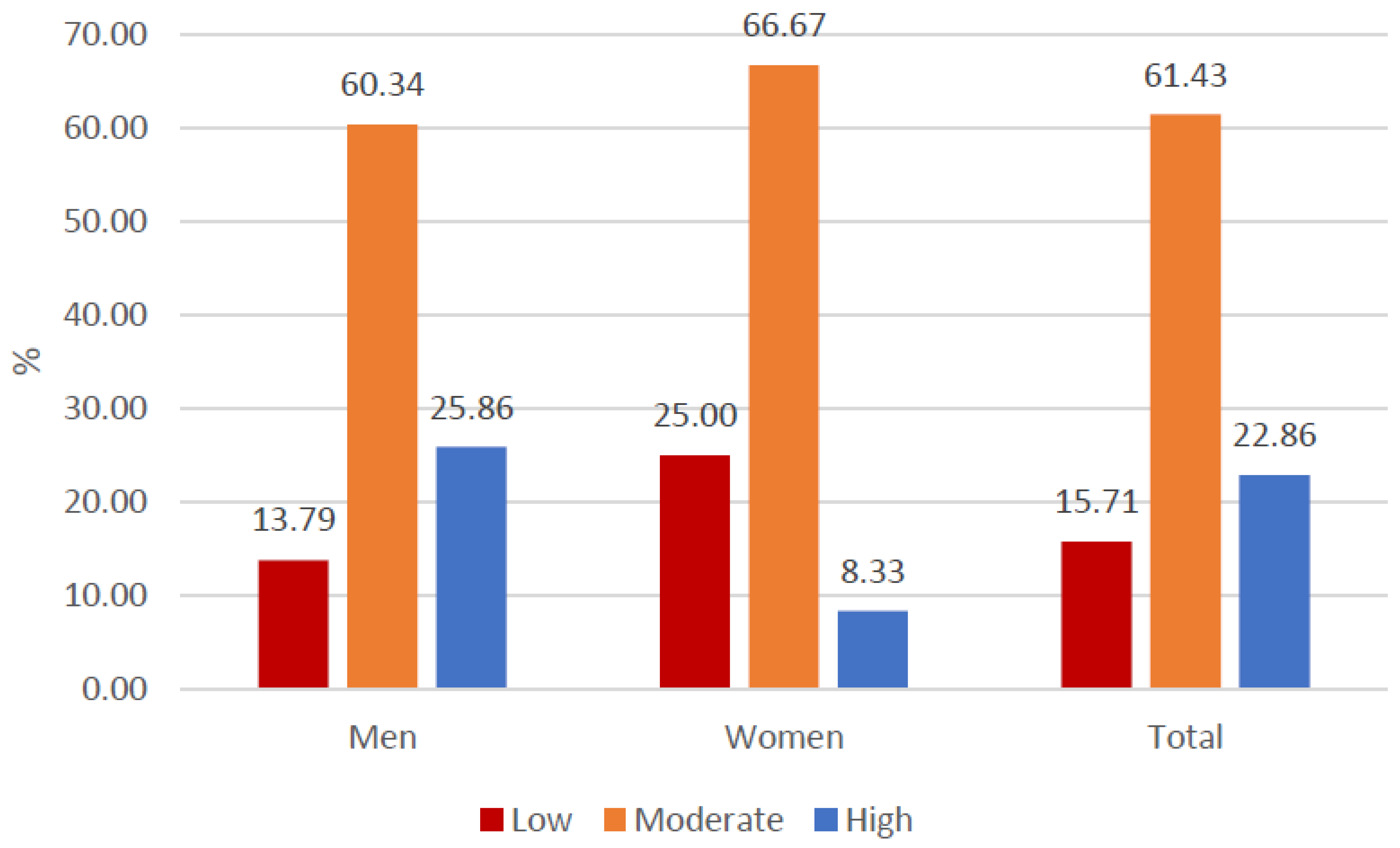
| Men (n = 58; 83%) | Women (n = 12; 17%) | Total (n = 70) | |
|---|---|---|---|
| Age x̄ (SD) | 57.34 (7.79) | 55 (6.59) | 56.94 (7.61) |
| Educational level-n (%) | |||
| Did not finish school | 14 (24.14%) | 2 (16.67%) | 16 (22.86%) |
| Primary education | 17 (29.31%) | 6 (50%) | 23 (32.86%) |
| Secondary education | 17 (29.31%) | 3 (25%) | 20 (28.57%) |
| Baccalaureate | 5 (8.62%) | 1 (8.33%) | 6 (8.57%) |
| University | 5 (8.62%) | 0 (0%) | 5 (7.14%) |
| Marital status-n (%) | |||
| Single | 27 (46.55%) | 2 (16.67%) | 29 (41.43%) |
| Married | 4 (6.9%) | 1 (8.33%) | 5 (7.14%) |
| Divorced/Separated | 12 (20.69%) | 2 (16.67%) | 14 (20%) |
| Widowed | 4 (6.9%) | 1 (8.33%) | 5 (7.14%) |
| Has a partner | 11 (18.97%) | 6 (50%) | 17 (24.29%) |
| Occupation-n (%) | |||
| Employed | 5 (8.62%) | 2 (16.67%) | 7 (10%) |
| Unemployed | 53 (91.38%) | 10 (83.33%) | 63 (90%) |
| Number of children-n (%) | |||
| 0 | 19 (32.76%) | 2 (16.67%) | 21 (30%) |
| 1 | 14 (24.14%) | 3 (25%) | 17 (24.29%) |
| 2 | 15 (25.86%) | 3 (25%) | 18 (25.71%) |
| 3 | 6 (10.34%) | 0 (0%) | 6 (8.57%) |
| 4 | 1 (1.72%) | 2 (16.67%) | 3 (4.29%) |
| 5 or more | 3 (5.17%) | 2 (16.67%) | 5 (7.14%) |
| Prison history-n (%) | |||
| Yes | 38 (65.52%) | 4 (33.33%) | 42 (60%) |
| No | 20 (34.48%) | 8 (66.67%) | 28 (40%) |
| Nationality-n (%) | |||
| Spanish | 57 (98.28%) | 12 (100%) | 69 (98.57%) |
| German | 1 (1.72%) | 0 (0%) | 1 (1.43%) |
| Coexistence-n (%) | |||
| Alone | 19 (32.76%) | 2 (16.67%) | 21 (30%) |
| With a partner | 8 (13.79%) | 6 (50%) | 14 (20%) |
| With a partner and children | 1 (1.72%) | 0 (0%) | 1 (1.43%) |
| With children | 1 (1.72%) | 0 (0%) | 1 (1.43%) |
| Shares a house | 29 (50%) | 3 (25%) | 32 (45.71%) |
| Street situation | 0 (0%) | 1 (8.33%) | 1 (1.43%) |
| Men (n = 57; 82.61%) | Women (n = 12; 17.39%) | Total * (n = 69) | |
|---|---|---|---|
| Duration of participation in the MMP-n (%) | |||
| <1 year | 3 (5.17%) | 2 (16.67%) | 5 (7.25%) |
| 1–5 years | 5 (8.62%) | 1 (8.33%) | 6 (8.70%) |
| 5–10 years | 6 (10.34%) | 1 (8.33%) | 7 (10.14%) |
| 10–20 years | 11 (18.97%) | 2 (16.67%) | 13 (18.84%) |
| 20–30 years | 22 (37.93%) | 3 (25%) | 25 (36.23%) |
| >30 years | 11 (18.97%) | 3 (25%) | 14 (20.29%) |
| Methadone treatment dose in mg/day—median (IQR) | 50 (30–80) | 40 (17.5–70) | 45 (30–80) |
| Delivery interval between doses in days—median (IQR) | 7 (7–14) | 7 (1–7) | 7 (7–14) |
| 1 day, n (%) | 7 (12.28%) | 4 (33.33%) | 11 (15.94%) |
| 7 days, n (%) | 28 (49.12%) | 6 (50%) | 34 (49.28%) |
| 14 days, n (%) | 19 (33.33%) | 2 (16.67%) | 21 (30.43%) |
| 28 days, n (%) | 3 (5.26%) | 0 (0%) | 3 (4.35%) |
| Comorbidities-n (%) | |||
| Hepatitis C | 27 (47.37%) | 4 (33.33%) | 31 (44.93%) |
| Hepatitis B | 1 (1.75%) | 0 (0%) | 1 (1.45%) |
| HIV | 11 (19.30%) | 1 (8.33%) | 12 (17.39%) |
| Cardiovascular disease | 16 (28.07%) | 1 (8.33%) | 17 (24.64%) |
| Mental pathology | 11 (19.30%) | 3 (25%) | 14 (20.29%) |
| Respiratory pathology | 9 (15.79%) | 2 (16.67%) | 11 (15.94%) |
| Musculoskeletal pathology | 10 (17.54%) | 1 (8.33%) | 11 (15.94%) |
| Oncological pathology | 3 (5.26%) | 0 (0%) | 3 (4.38%) |
| Neurological pathology | 4 (7.02%) | 0 (0%) | 4 (5.80%) |
| Pharmacological treatments-n (%) | |||
| Benzodiazepines | 41 (71.93%) | 6 (50%) | 47 (68.12%) |
| Antihypertensives | 12 (21.05%) | 1 (8.33%) | 13 (18.84%) |
| Neuroleptic anxiolytics | 20 (35.09%) | 4 (33.33%) | 24 (34.78%) |
| Inhalers | 14 (24.56%) | 2 (16.67%) | 16 (23.19%) |
| Gastric drugs | 15 (26.32%) | 4 (33.33%) | 19 (27.54%) |
| Oral antidiabetics | 6 (10.53%) | 3 (25%) | 9 (13.04%) |
| Insulin therapy | 3 (5.26%) | 2 (16.67%) | 5 (7.25%) |
| Non-opioid analgesia | 13 (22.81%) | 4 (33.33%) | 17 (24.64%) |
| Opioid analgesia | 7 (12.28%) | 0 (0%) | 7 (10.14%) |
| Platelet antiaggregant | 7 (12.28%) | 0 (0%) | 7 (10.14%) |
| CRL * | 95% CI ** | p | |
|---|---|---|---|
| Perceived social support | 8.12 | 0.51; 15.72 | 0.037 |
| Platelet antiaggregant | −11.32 | −23.36; 0.71 | 0.065 |
| Inhalers (respiratory therapy) | −9.37 | −17.97; −0.77 | 0.033 |
| R2 Adjusted = 0.1435 | |||
| CRL * | 95% CI ** | p | |
|---|---|---|---|
| Perceived social support | 13.08 | 4.47; 21.69 | 0.003 |
| Mental pathology | 7.68 | −2.53; 17.89 | 0.138 |
| R2 Adjusted = 0.1123 | |||
| CRL * | 95% CI ** | p | |
|---|---|---|---|
| Perceived social support | 17.78 | 9.32; 26.23 | 0.000 |
| Anxiolytics (nonbenzodiazepines)/neuroleptics | −13.64 | −22.22; −5.05 | 0.002 |
| HIV | −13.61 | −24.26; −2.96 | 0.013 |
| R2 Adjusted = 0.2731 | |||
| CRL * | 95% CI ** | p | |
|---|---|---|---|
| Perceived social support | 12.97 | 6.22; 19.72 | 0.000 |
| R2 Adjusted = 0.1479 | |||
| CRL * | 95% CI ** | p | |
|---|---|---|---|
| Insulin therapy | −0.65 | −1.20; −0.10 | 0.020 |
| R2 Adjusted = 0.086 | |||
| OR * | 95% CI ** | p | |
|---|---|---|---|
| Coexistence (family) | 0.73 | 0.18; 2.99 | 0.661 |
| Coexistence (sharing a home) | 3.84 | 1.07; 13.83 | 0.040 |
| Employment | 6.99 | 0.65; 75.04 | 0.109 |
| Pseudo R2 = 13.56 | |||
Disclaimer/Publisher’s Note: The statements, opinions and data contained in all publications are solely those of the individual author(s) and contributor(s) and not of MDPI and/or the editor(s). MDPI and/or the editor(s) disclaim responsibility for any injury to people or property resulting from any ideas, methods, instructions or products referred to in the content. |
© 2025 by the authors. Licensee MDPI, Basel, Switzerland. This article is an open access article distributed under the terms and conditions of the Creative Commons Attribution (CC BY) license (https://creativecommons.org/licenses/by/4.0/).
Share and Cite
López-Paterna, P.; Erahmouni-Bensliman, I.; Sánchez-Ruano, R.; Rodríguez-Barrientos, R.; Rico-Blázquez, M. Quality of Life, Perceived Social Support, and Treatment Adherence Among Methadone Maintenance Program Users: An Observational Cross-Sectional Study. Healthcare 2025, 13, 1849. https://doi.org/10.3390/healthcare13151849
López-Paterna P, Erahmouni-Bensliman I, Sánchez-Ruano R, Rodríguez-Barrientos R, Rico-Blázquez M. Quality of Life, Perceived Social Support, and Treatment Adherence Among Methadone Maintenance Program Users: An Observational Cross-Sectional Study. Healthcare. 2025; 13(15):1849. https://doi.org/10.3390/healthcare13151849
Chicago/Turabian StyleLópez-Paterna, Pedro, Ismail Erahmouni-Bensliman, Raquel Sánchez-Ruano, Ricardo Rodríguez-Barrientos, and Milagros Rico-Blázquez. 2025. "Quality of Life, Perceived Social Support, and Treatment Adherence Among Methadone Maintenance Program Users: An Observational Cross-Sectional Study" Healthcare 13, no. 15: 1849. https://doi.org/10.3390/healthcare13151849
APA StyleLópez-Paterna, P., Erahmouni-Bensliman, I., Sánchez-Ruano, R., Rodríguez-Barrientos, R., & Rico-Blázquez, M. (2025). Quality of Life, Perceived Social Support, and Treatment Adherence Among Methadone Maintenance Program Users: An Observational Cross-Sectional Study. Healthcare, 13(15), 1849. https://doi.org/10.3390/healthcare13151849







